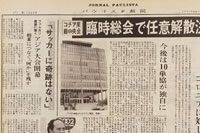Postwar emigration agencies
Kaikyoren and the Nihon Kaigai Iju Shinko (Japanese Overseas Emigration Promotion)
With the resumption of emigration, emigration related agencies were also established within the Japanese Government and the Nippon Kaigai Kyokai Rengokai (Federation of Japan Overseas Associations, abbreviated as "Kaikyoren") was established in January 1954 as an affiliated organization of the Ministry of Foreign Affairs to carry out recruitment, selection and shipment procedures of emigrants within Japan as well as receiving procedures within emigration destination countries. The emigration sections of each prefecture and prefectural kaigai kyokai (overseas associations) were in charge of recruitment and selection of emigrants and Kaikyoren was in charge of the shipment of emigrants and subsequent work, and Kaikyoren took over the authorized limit of the Tsuji and Matsubara emigrants and shipped emigrants within the limit from 1955 onwards.
On September 27, 1955, the Nihon Kaigai Iju Shinko Kabushiki-gaisha (Japan Emigration Promotion Company Co. Ltd) was established (by Act No. 139 of August 5, 1955) to purchase land in emigration destination countries and construct settlements with loans from banks in U.S., and sell the land in lots to self-employed reclaiming emigrants.
JAMIC and JEMIS
In addition, two overseas affiliated companies were established, JAMIC (Japanese Immigration and Colonization), which took charge of constructing settlements and guiding farming management, and JEMIS (Japan Emigration Service ), which took charge of financing emigrants from various sources of funds.
Postwar settlements
The 2nd Tome-Acu settlement (inaugurated in 1963 in the State of Para), the Varzea Alegre settlement (inaugurated in 1959 in the State of Mato Grosso do Sul), the Funchal settlement (inaugurated in 1961 in the State of Rio de Janeiro to receive unemployed coal miners in the Bibai and Miike), the Jacarei settlement (inaugurated in 1961 in the State of São Paulo) and the Guatapara settlement (inaugurated in 1962) were constructed as settlements under the direct administration of JAMIC and land in the settlements were sold in lots.
Of these settlements, in the Varzea Alegre settlement land was found infertile, due to inappropriate advance surveys, after emigrants had settled, which caused the emigrants to experience severe difficulties and compelled many of them to leave the settlement. Land for the Guatapara settlement was purchased by the Zenkoku Takushoku Nogyo Kyodo Kumiai Rengokai (National Federation of Colonization and Agriculture Cooperatives, abbreviated as "Zentakuren") under the Ministry of Agriculture and Forestry with financial assistance from 7 prefectures on the condition that land improvements should be carried out by Japanese agriculture engineers, and due to financial difficulties all the projects in the Guatapara settlement were taken over by the Iju Shinko Kaisha (Emigration Promotion Company), but the land improvements failed to achieve the desired and planned results.
JAMIC also carried out the reception of emigrants into self-employed reclaiming colonies constructed by the Brazilian Federal Government and state governments. The Brazilian side was obliged to reclaim, receive emigrants at sites, provide loans to farming management, guide farming management in the colonies constructed by the Brazilian side, however it often failed to fulfill its obligations which caused the emigrants to experience severe difficulties and compelled many of them to leave the colonies.
Japan Emigration Service and Japan International Cooperation Agency
On July 15, 1963, the Kaikyoren and the Iju Shinko Kaisha (Emigration Promotion Company) were integrated to establish the Japan Emigration Service (Act no. 124 of July 8, 1963). Then, in August 1974, the Japan Emigration Service was absorbed into the Japan International Cooperation Agency through the dissolution and integration of government-affiliated corporations. The Brazilian side, however, pointed out that with the absorption into the Japan International Cooperation Agency, a violation of Brazilian law had occurred, and consequently both JAMIC and JEMIS were unavoidably shut down on September 29, 1981. In the Japan International Cooperation Agency, emigration-related branches were greatly reduced in fiscal year 1994, and then completely dissolved with the transformation into an independent administrative corporation in October of 2003.
Changes in the Japanese community
Nisei advance in society
Nisei (second generation of Japanese immigrants) have made a conspicuous progress in Brazilian society. Fabio Ryoji Yasuda was appointed Minister of Commerce and Industry in 1969, Shigeaki Ueki was as Minister of Mines and Energy in 1974 and Seigo Tsuzuki as Minister of Health in 1989. In 2007, Jun'ichi Saito became supreme commander of the Brazilian Air Force.
Dekasegi in Japan
In the 1980s in Brazil, inflation exceeded 1000% per year and many Brazilians began emigrating to the United States, Portugal, Italy and other countries to earn money. From around 1984 onwards, Nikkei (people of Japanese descent) in Brazil also began going to Japan as dekasegi (temporary emigrants who intended to make money and return home, "Dekassegui" written in Portuguese taken from the Japanese word). There was a boom in dekasegi from the second half of 1986 onwards.
Nikkei Nisei (the second generation of Japanese emigrants) already had the residence status which allowed them to resident in Japan with no work restriction, but the amendment to the Immigration Control Act in June of 1989 and the notification relating to permanent residence in 1990, also gave "permanent resident", resident status with no work restriction, to the spouses of Nisei as well as Nikkei Sansei (the third generation of Japanese emigrants) and their spouses. Afterwards, due to economic and employment situations in Brazil as well as the difference in wages between the two countries, the number of dekasegi from Brazil increased remarkably. In 2005 the number of registered aliens with Brazilian citizenship in Japan was more than 300,000, which had already surpassed the number, 260,000, of the Japanese people who emigrated to Brazil both before and after the war.
Among those who originally came to Japan as dekasegi intending to earn money and return to Brazil, the number of those who wished to permanently resident in Japan increased. But a lack of education of their children and delinquency as result of it have become a serious social problem. Among estimated 1.5 million people in the Japanese community in Brazil, a fifth of them, especially young and middle aged generations in the prime of life, are staying in Japan, which has caused the problem of the hollowing-out of the Japanese community.
-

 Portuguese language newspapers published in Japan for Brazilian of Japanese descent in Japan
Portuguese language newspapers published in Japan for Brazilian of Japanese descent in Japan
Progress in Assimilation of Japanese descent people
It is estimated that currently about 1.5 million people of Japanese descent are living in Brazil. This does not mean, however, that there is a community of 1.5 million Japanese descent people who have a sense of solidarity to support each other, as in the community of Japanese residing in Brazil before the war or in the Japanese colonia after the war.
It is said that the Japanese Colonia reached their peak with the celebrations of 70 years of immigration in 1978 and began to decline afterwards. The Issei and Nisei who decided to settle permanently in Brazil after the war, made efforts to give their children good education. Thanks to them, the successive generations of Japanese descent people have got diplomas of higher education and have advanced their career in Brazilian society. They no longer need the Colonia where Japanese help each other in solidarity, and so no longer need to stay in the Colonia. As a result, the Colonia is composed of only Issei and a portion of Nisei, and as these people age, the Colonia will continue to decline.
In the 1990s the core organizations of the Colonia which led it in the postwar era, the Cotia Agricultural Cooperative, Nanpaku Nokyo Chuokai (South Brazil Central Committee of Agricultural Cooperatives) and the Nanbei Ginko (Bank of South America), also faded away, which reflected a decline of the Colonia.
According to the 1958 Colonia situation survey, 3.5% of Japanese descent people were married with a spouse of non-Japanese descent, up to 13.6% in the supplementary survey in 1962, and 45.9% in the 1988 survey. Many of Nisei abstained from intermarriage because of their Issei parents’ opposition, but there were no longer obstacles in the way of Sansei and Yonsei. This caused a rapid increase in the share of mixed race persons (according to the survey in 1988, 42% of Sansei and 62% of Yonsei were mixed race persons), and it is said that it will be difficult to define Nikkejin (Japanese descent people) racially in the near future.
Future of the Japanese community
While Nikkeijin (Japanese descent people) have a tendency to rapidly assimilate into Brazilian society, some of them have made an assertion that they should, like German, Italian or other diasporas, preserve their home country culture, and positively pass it down to later generations to contribute to Brazilian society. Some have made an assertion that many educational facilities should be established to spread virtues such as cooperativeness, solidarity, perseverance, honesty, sincerity among Brazilian society through education and diligence that Japanese immigrants showed, which virtues would be a great boon to Brazilian society. At present they are trying to establish of Japanese educational facilities including universities.
Among Sansei and their later generations , there have appeared dekasegi who often travel between Japan and Brazil, and those who, interested in anime, J-POP, Yosakoi Soran, Wadaiko (Japanese drums) and other aspects of Japanese culture introduced to Brazil through the internet, have formed groups of people sharing these common interests to engage in cultural activities. They have become aware of their own Japanese ethnicity through these activities.








